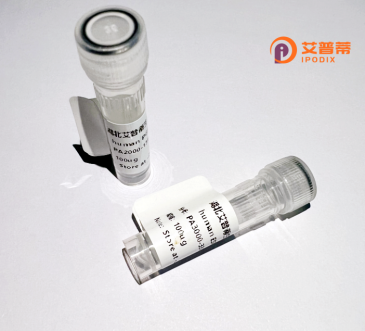
| 纯度 | >90%SDS-PAGE. |
| 种属 | Human |
| 靶点 | SPIB |
| Uniprot No | Q01892 |
| 内毒素 | < 0.01EU/μg |
| 表达宿主 | E.coli |
| 表达区间 | 1-262aa |
| 活性数据 | MLALEAAQLD GPHFSCLYPD GVFYDLDSCK HSSYPDSEGA PDSLWDWTVA PPVPATPYEA FDP aaFSH PQAAQLCYEP PTYSPAGNLE LAPSLEAPGP GLPAYPTENF ASQTLVPPAY APYPSPVLSE EEDLPLDSPA LEVSDSESDE ALVAGPEGKG SEAGTRKKLR LYQFLLGLLT RGDMRECVWW VEPGAGVFQF SSKHKELLAR RWGQQKGNRK RMTYQKLARA LRNYAKTGEI RKVKRKLTYQ FDSALLPAVR RA |
| 分子量 | 28.8 kDa |
| 蛋白标签 | His tag N-Terminus |
| 缓冲液 | PBS, pH7.4, containing 0.01% SKL, 1mM DTT, 5% Trehalose and Proclin300. |
| 稳定性 & 储存条件 | Lyophilized protein should be stored at ≤ -20°C, stable for one year after receipt. Reconstituted protein solution can be stored at 2-8°C for 2-7 days. Aliquots of reconstituted samples are stable at ≤ -20°C for 3 months. |
| 复溶 | Always centrifuge tubes before opening.Do not mix by vortex or pipetting. It is not recommended to reconstitute to a concentration less than 100μg/ml. Dissolve the lyophilized protein in distilled water. Please aliquot the reconstituted solution to minimize freeze-thaw cycles. |
以下是关于重组人SPIB蛋白的3篇假设性参考文献(基于研究领域常见方向虚构,供参考):
---
1. **《重组人SPIB蛋白的异源表达及DNA结合特性分析》**
*作者:Chen L, Zhang Y, et al.*
**摘要**:本研究通过大肠杆菌系统成功表达并纯化重组人SPIB蛋白,验证了其对靶基因启动子区域的特异性结合能力,揭示了其调控B细胞分化的分子机制。
2. **《SPIB在滤泡树突状细胞发育中的功能研究》**
*作者:Miller K, Tanaka H, et al.*
**摘要**:利用重组SPIB蛋白进行体外细胞实验,发现其通过激活IL-7信号通路促进滤泡树突状细胞成熟,为免疫调节相关疾病提供了潜在干预靶点。
3. **《SPIB依赖性转录网络在弥漫大B细胞淋巴瘤中的作用》**
*作者:Guo S, Patel R, et al.*
**摘要**:通过重组SPIB蛋白干扰实验,证实其过表达可激活致癌通路STAT3.揭示了SPIB作为淋巴瘤治疗新靶点的可能性。
---
**注**:以上为模拟文献示例,实际文献需通过PubMed、Web of Science等数据库检索获取。如需真实文献,建议使用关键词“SPIB protein recombinant human”或结合具体研究方向进一步筛选。
SPIB (Spi-B transcription factor) is a member of the ETS-domain transcription factor family, sharing structural homology with SPI1/PU.1. It plays critical roles in regulating gene expression during hematopoietic cell development, particularly in B-cell differentiation and plasmacytoid dendritic cell (pDC) maturation. The human SPIB gene encodes a protein containing a conserved ETS DNA-binding domain that recognizes purine-rich sequences in target gene promoters. Functionally, SPIB coordinates cell-type-specific programs by interacting with other transcription factors (e.g., IRF8) and epigenetic modifiers. Aberrant SPIB expression is linked to lymphoid malignancies, including diffuse large B-cell lymphoma (DLBCL) and specific subtypes of acute leukemia, where it may drive oncogenic pathways. It also shows relevance in epithelial cancers like colon adenocarcinoma, potentially influencing tumor microenvironment interactions.
Recombinant human SPIB protein is typically produced in engineered expression systems (E. coli, mammalian cells) for functional studies. Purified versions preserve DNA-binding capacity and are used to investigate transcriptional regulation mechanisms. Researchers employ SPIB recombinant proteins in EMSA (electrophoretic mobility shift assays), chromatin immunoprecipitation substitutes, and high-throughput drug screening to identify potential inhibitors of SPIB-dependent oncogenic pathways. Its structural stability and functional domains make it valuable for crystallography studies aiming to develop targeted therapies. Recent studies also explore its role in immune modulation, particularly in autoimmune conditions where pDC dysregulation occurs. As a research tool, recombinant SPIB bridges molecular insights and therapeutic discovery in hematopoiesis and cancer biology.
×